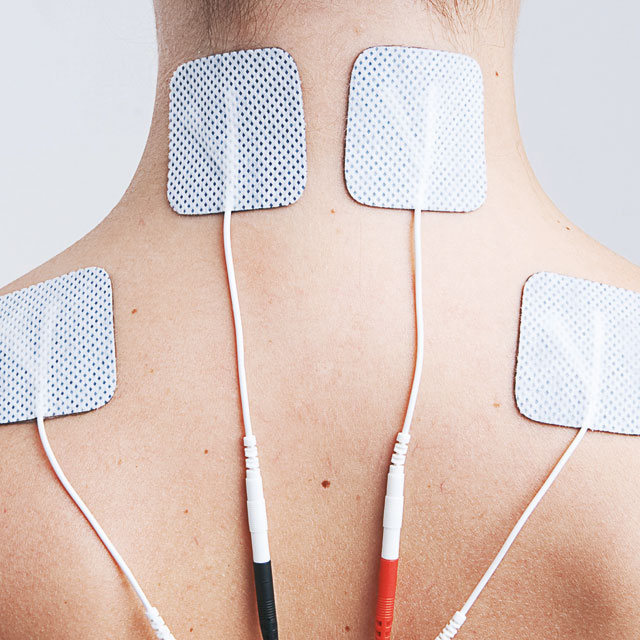TENS describes the application of electrical impulses that act on the nerves through the skin. TENS therapy has been a recognized pain therapy method for the relief of acute and chronic pain for over 25 years.
Handy, battery-operated digital 2-channel devices are used to reach and stimulate specific nerves on the body with electrical impulses. In many cases, this stimulation will significantly reduce or even completely eliminate the patient’s perception of pain.
The TENS method is a very practicable form of non-invasive electrotherapy using special stimulation current, electrode and application criteria. Therapeutic electrical stimulation triggers nerve reactions and neuro-modulatory regulation, and is therefore one of the targeted reflex and stimulation therapies. The main objectives of the therapy are pain suppression, blood circulation optimization, muscle relaxation, as well as the reflex effect on visceral organ systems and endocrine glands or reflex therapeutic effects.
TENS therapy also leads to the optimization of central endogenous regulation and impulse control systems. TENS impulses block transmission to the brain and stimulate the body’s natural release of endorphins, which can also reduce pain. TENS treatment can be used to harmonize (or eutonize) the psychovegetative tone, to increase performance and thus for prophylaxis.

TENS (transcutaneous electrical muscle stimulation) with electrodes
The transmission of nociceptive information is inhibited via the stimulated nerves at the dorsal horns of the spinal cord, as a result of which the pain is no longer perceived.
The continuous pulse sequence or conventional stimulation works with constant frequencies and pulses. The fixed frequency can be up to 150 Hz and the pulse duration up to 300 µs. The intensity is adjusted so that the stimulation causes strong but pleasant paraesthesia (tingling) in the area of pain. This form of treatment is indicated for most applications at the beginning, especially for acute pain.
Stimulation of the posterior cord fibers or certain subcortical brain structures can cause inhibition via serotonin and noradrenaline, and endorphins are also released.
The burst mode stimulates with 2 – 4 pulse blocks per second at a frequency of 0.5 to 5 Hz and a pulse duration of 100 to 300 µs. The intensity is adjusted so that the stimulation causes visible but painless muscle contractions. This form of treatment releases β-endorphins centrally.
| Theory | Gate control effect (continuous pulse sequence) | Endorphin release (burst) |
| Mode of action | via motor nerves | via sensory nerves |
| Intensity | low, slight tingling | high, just bearable |
| Pulse duration (pulse width) | short (30 – 300 µs) | long (150 – 300 µs) |
| Pulse frequency | 50 – 150 Hz | 0.5 – 5 Hz |
| Muscle contraction | no | yes |
| Onset of pain relief | fast | slow (20 – 60 min.) |
| Duration of pain relief | short (5 – 15 min.) | long (20 min. – 12 hours) |
| Duration of treatment | Start with 3 x 20 – 30 minutes (later increase as required) | 30 min. 2 – 3 x daily |
Modulated stimulation works with regularly fluctuating frequencies. The settings correspond to conventional stimulation (standard values 100 Hz / 200 µs), whereby the frequency (Hz) or the pulse duration (µs) is continuously changed between 40-70 %. This form of therapy prevents accommodation or counteracts habituation tendencies of nerves and muscles and is particularly indicated for longer therapy durations and chronic pain conditions.
By varying the carrier pulse duration, pulse frequency and pulse modulation, different analgesic and motor effects can be achieved. innoTENS devices contain sufficient variability of pulse parameters to trigger differentiated effects for different indications.
Muscle and nerve stimulation through stimulation current Multifunctional therapy device...
Digital TENS device for successful pain treatment Relief from chronic...
innoSTIM-ET Muscle and nerve stimulation through stimulation current Multifunctional therapy...
3-in-1 combination device for pain treatment and muscle building The...
Higher frequencies
Lower frequencies
Historical overview
HELLER MEDIZINTECHNIK GmbH & Co. KG has been a certified medical technology company for over 25 years and has many years of experience in designing solutions in the field of electrical nerve and muscle stimulation.
2025 © HELLER MEDIZINTECHNIK GmbH & Co. KG